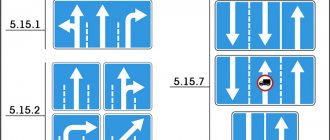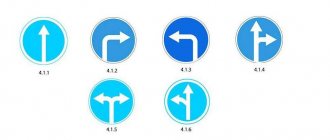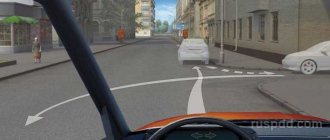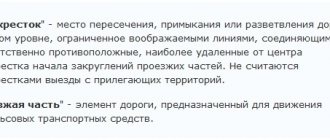Many car owners face a situation where it is necessary to make a U-turn on tram tracks every day. However, according to statistics, more than a third of them do not have the slightest idea how to safely perform this maneuver and only 20% are aware of the penalties that may entail its incorrect execution.
After reading this article, you will learn: how to correctly make a U-turn on tram tracks at an intersection or beyond, what nuances there are when driving along them, and what fines are provided for this.
Traffic on tram lines
Before starting a conversation about the possibilities and prohibitions for car owners related to turning around on tram tracks, it is worth recalling that any manipulations carried out on them should not interfere with other traffic participants! So, what exactly is allowed by traffic rules.
According to clause 9.6, movement is permitted provided that if other lanes located in the same direction are occupied and turn left from the tram tracks in the same direction, if this maneuver does not contradict clause 8.5. Traffic rules In this case, they should be located on the left side of the car’s lane, and located at the same level as the roadway. Advancing (not overtaking) on passing rails is also allowed.
Turning at an intersection with tram tracks
Turning left from tram tracks, as well as turning across them, are carried out in the same way. However, you need to be careful in several other aspects:
- Do not try to cross the tram tracks located on the left side of the driver, perpendicular to both directions of movement of electric transport. Changing to co-directional tram tracks is mandatory in any case.
- In situations where a traffic controller or traffic light simultaneously allows the movement of both types of transport, according to clause 13.6 of the Road Traffic Rules, car drivers are required to let a representative of rail transport pass.
- An exception to the above point is the situation when, simultaneously with warning or prohibiting traffic lights, the arrow in the direction of movement is lit, then motorists and tram drivers change places, and the latter give way to the former.
Rules for making a left turn or U-turn when there are tram tracks at an intersection.
In what cases is it prohibited to cross tram tracks?
may encounter such a situation
If they pass on the right side of the lane.- Located above or, conversely, below the level of the road. In this case, they act as a dividing strip, which means that driving onto it is prohibited.
- Tram tracks are counter-traffic for cars. Driving them in this case may result in the driver being deprived of his license.
Turning around when there are prohibiting road markings . U-turn is prohibited on:
- Railway crossing;
- Places with road visibility no more than 100 m;
- Places designated specifically for public transport stops;
- Bridges, overpasses and overpasses (including under them);
- Pedestrian crossings;
- Tunnels.
How to perform the maneuver correctly
When making a left turn, the initial position of the vehicle is important. If you are on a different track, you will first need to change lanes to the far left. Only from it will it be possible to perform the necessary maneuver.
Please note that trams must move in the same direction as the traffic flow and are located on the left. Driving onto oncoming roads is prohibited in all cases. If there is a solid line separating the tracks from the roadway, a U-turn is also impossible.
In the absence of prohibitory signs, the driver turns as follows:
- Turns on the corresponding turn signal.
- Looks in the side mirror to assess the situation.
- Lets passing trams or other vehicles that have prepared for the maneuver ahead of him.
- Monitors the absence of oncoming traffic.
- Changes to an adjacent road.
If you don’t need to change lanes from row to row, turning is even easier.
In most cases, turning left across the tram tracks is not difficult, because the traffic density of this type of transport is not so high.
At the crossroads
Intersections are places where turning and turning maneuvers are permitted.
The presence of tram tracks on them is no exception to the rule. When crossing paths at signalized intersections, you should pay attention to the traffic light signal. If there is a tram traffic light, then it is also taken into account. Do not forget about additional sections of traffic lights that can block turns when the general light is green.
When turning at an intersection, do not forget about the main rules. The driver first evaluates whether the road he is driving on is a main one or a secondary one. If there are no traffic lights, then you need to rely on the installed road signs.
The tram always has priority over other road users. He is obliged to let the vehicle through only if his traffic light is on or he is leaving the depot.
A driver turning left must give way to the tram and all cars moving towards or to the right. If it is not possible to determine whether the road is a main or a secondary one, then you should behave as if it were a secondary road.
Outside the intersection
Paragraph 8.11 of the traffic rules comprehensively describes cases when you cannot make a U-turn on the road. The presence of rails on the road does not prohibit turning or turning around. Tram tracks can be crossed subject to a number of mandatory rules. The trajectory of movement in accordance with paragraph 8.5 of the Rules must be sufficient to complete the maneuver, but not exceed the need.
When turning left outside an intersection, the driver must allow:
- tram;
- oncoming traffic;
- vehicles that had prepared for a similar maneuver before him.
Only after this can he freely cross the track. You can start turning from the far right side of the lane.
If there are tram lines in the same direction
In normal situations, you cannot drive along the tracks in the same direction. But if there is an insurmountable obstacle, for example, an accident or a fallen tree, such movement is permitted, provided that the vehicle does not interfere with the tram.
If the driver started a maneuver, but did not have time to complete it due to heavy oncoming traffic, then according to the rules he must return to his starting position. Of course, doing this in 99% of cases is simply impossible, since other cars have already pulled up behind you. In this case, you must first give way to the tram, and then continue the maneuver. In heavy traffic, you can see a situation where a car travels on passing rails in front of a tram, looking for the moment to leave its line of movement.
To avoid such situations, it is recommended to more carefully choose the place to turn left.
At the crossroads
If the tram lines allow the tram to carry out any maneuver, such as crossing, moving in a straight line or turning left. If in your situation at an intersection the paths connect the direction, then the rules of passage will be significantly simplified for you . That is, when driving through the road section along which you approach the intersection, tram tracks located on the same level as it are shared. Is it possible to perform a reversal in this case?
According to clauses 8.5 and 9.6. stipulated in the traffic rules, you have the right (and in some cases it is even necessary) to drive onto the tram tracks in order to turn around. At the same time, your maneuver should not violate established signs and road markings. In addition, the driver must not interfere with other road users.
As for the relationship between drivers of cars and trams at controlled intersections of the road, they are discussed in paragraph 13.6 of the traffic rules , where it is written that if traffic light signals simultaneously allow all vehicles to start moving, then the tram will always have priority, regardless of the direction in which he is moving.
However, if the driver needs to move in the direction of the arrow, which lights up in the additional section along with a red or yellow signal, then the tram driver is obliged to give way to vehicles moving from other directions.
Please note that this article describes only general rules regarding U-turns and turns from tram tracks, since there are many different combinations, depending on their location, as well as traffic controller gestures, traffic lights, etc.
Common Questions
- When is it prohibited to drive onto tram tracks? Access to tram rails is prohibited if they are not at the same level as the main road, are in the oncoming direction, are separated from the roadway by a solid line, have a sign requiring direct movement along the lanes, or are occupied by a tram or other vehicles. If we are talking about their intersection for a turn or turn, then in this case the continuous markings lose their significance, which prohibits only changing lanes to perform maneuvers.
- Can my license be revoked for driving on tram rails? A driver can lose his license only for stopping or driving into oncoming traffic, as well as for repeated violation of such a plan.
Caution on the roads is the key to successful driving, which is especially important for novice drivers. As for trams, if you are unsure about the legality of your own actions, it is better to give way to rail transport, especially since such an act will not be considered a gross violation.
Outside the intersection
In order to make a U-turn across tram tracks outside the intersection , the driver must:
- Make sure they are on your left side and above the roadway. In addition, there are no restrictions described above in the form of markings and signs.
- Give way to passing trams and change lanes onto the tram tracks in the same direction.
- Turn on the turn signal, and after making sure there are no obstacles, make a U-turn.
- Trams traveling in the oncoming lane must also be allowed through.
The most common mistakes made when turning left across a tram line:
- The turn should start from the roadway, but not from the tram tracks. Although this is not considered a violation and no punishment is provided for such a maneuver. However, you must understand that in this case you significantly increase the risk of an accident. Therefore, the turn should be made from oncoming tram tracks.
- In this case, you violate clause 9.6. from the traffic rules, which clearly state about leaving with further movement along tram tracks in the opposite direction.” Thus, when entering this section, your car will not be positioned perpendicular to the tracks, the maneuver may be regarded by traffic police inspectors as driving onto the tram tracks of the opposite direction, which means that such a violation will entail punishment in the form of a fine.
- If you need to make a left turn in relation to parked cars, the maneuver must be started when the front of your car and the parked car are in the same line. This positioning, in a limited space, will allow you to avoid a collision with a parked car.
Difficulties that arise when turning left and making U-turns
- Changing the direction of movement to the left should be done so that when leaving the intersection you do not end up in the lane of oncoming traffic.
- If there is no dividing line, when turning left with an oncoming driver, you will pass on the right sides. Neither you nor oncoming drivers need to go around the center of the intersection.
- This kind of left turn (U-turn) is the safest, because... in this case the trajectories will not intersect.
- If there is a dividing line at the intersection, then the road consists of two carriageways, which means that there are 2 intersections at the intersection.
- Then it is mandatory to bypass the center of the intersection when turning left.
How to avoid an accident when making a left turn?
According to the rules of the road, when turning left, these conditions must be met:
- The driver must first take the far left seat on the road.
- Near tram lines, you can also turn from the tracks if you do not interfere with the movement of trams.
- Driving in oncoming traffic when turning left is strictly prohibited and you may be subject to a heavy fine, including the confiscation of your driver's license.
- If it is necessary for a long truck to turn left (while observing the necessary safety precautions), it is permitted to waive some of the rules described here.
Fines for entering tram tracks
The number of road accidents involving tram and car drivers is increasing significantly every year. In 95% of cases, the culprit of an emergency situation is the car driver, since when entering the tram tracks, he should not create obstacles to the movement of trams. As for cases where the culprit is the tram driver (who, for example, started moving at a prohibiting signal), unfortunately, they also occur, but their number does not exceed 5% of all cases. However, even without creating an emergency when driving on tram tracks, the traffic police inspector can fine the driver or even deprive him of his driver’s license.
will directly that was violated in this case. So:
- For stopping on tram tracks, the driver faces a fine of 3 thousand rubles, if this happened in St. Petersburg or Moscow. In other cities located in the Russian Federation - 1.5 thousand rubles.
- For interfering with a tram going in the same direction - a fine of 500 rubles.
- For failure to comply with road marking rules, the fine is from 500 to 1,500 rubles (this applies to turning or turning around).
- The initial trip to the oncoming lane of tram tracks will cost 5 thousand rubles (or you may be deprived of your license for a period of 4 to 6 months). For a subsequent similar violation - deprivation of the license for a year.
- Driving into the oncoming lane of tram tracks to avoid an obstacle will result in a fine of 1 thousand to 1.5 thousand rubles.
Remember that when turning around on tram tracks, you must always let the tram pass , even in cases where its movement grossly violates traffic rules. Otherwise, the consequences of an accident for your car, and for yourself, may be much more serious than for a tram.
Is it allowed to turn on the tracks?
Tram tracks can baffle even seasoned drivers. But if you remember the basic rules for moving across the tram track, then no problems will arise. When turning left, remember that you can turn around unless there are special signs prohibiting such maneuvers on the tracks in the same direction.
Such signs in the traffic rules include:
- 19 “U-turn prohibited”;
- 1.1 "Move straight ahead."
In all other cases, the driver has the right to turn left and cross the tram tracks. When performing a maneuver, it is important to remember the algorithm for performing such an action.
Making a U-turn across tram tracks
The Rules do not contain a definition of the concept of “turn”. In practice, such a maneuver means the process of moving a car to the opposite lane from the original one.
When making a U-turn across tram rails, you must adhere to certain rules:
A U-turn can only be made from the leftmost lane, which in this case is the lane for rail public transport.- Before performing a turn, you need to make sure that the actions you perform do not contradict the law (there are no signs or markings prohibiting the maneuver).
- Before turning, you need to make sure that it is safe and that there are no trams in the passing or oncoming lane. If rail transport is nearby, it is better to postpone the turn for a while and let the tram pass.
- When making a U-turn, you must move in such a way that your car is perpendicular to the tram tracks. If, after making a U-turn, the motorist moves in the oncoming lane for some time, traffic police officers have the right to hold him accountable under the relevant article.
Selecting a position on the roadway before an intersection
In the second article of the series, we already discussed how to take the correct position on the roadway when approaching an intersection. For intersections with tram tracks, the basic principles remain the same. However, there are small exceptions.
If there are tram tracks located in the center of the roadway along which you are approaching the intersection, and they are at the same level as the roadway, then in some cases you can drive onto these tracks. Moreover, sometimes the driver is required to enter the intersection along the tram tracks.
Let's consider paragraphs 8.5 and 9.6 of the traffic rules:
8.5. Before turning right, left or making a U-turn, the driver is obliged to take in advance the appropriate extreme position on the roadway intended for traffic in this direction, except in cases where a turn is made when entering an intersection where a roundabout is organized.
If there are tram tracks in the same direction on the left, located at the same level as the roadway, a left turn and a U-turn must be made from them, unless signs 5.15.1 or 5.15.2 or markings 1.18 prescribe a different movement order. In this case, there should be no interference with the tram.
9.6. It is permitted to travel on tram tracks in the same direction, located on the left at the same level as the roadway, when all lanes in this direction are occupied, as well as when detouring, overtaking, turning left or making a U-turn, taking into account clause 8.5 of the Rules. In this case, there should be no interference with the tram. It is prohibited to drive onto tram tracks in the opposite direction. If road signs 5.15.1 or 5.15.2 are installed in front of the intersection, movement on tram tracks through the intersection is prohibited.
Turn left or make a U-turn
If tram tracks are located in the center of the roadway, on the same level with it, then the driver is obliged to make a left turn and a U-turn precisely from the tracks in the same direction. In the picture above, the blue car is in position to turn left.
However, in some cases you should not drive onto the path. We are talking about the presence of signs 5.15.1 or 5.15.2 on the road:
If at least one of these signs is located above at least one of the traffic lanes, then entering tram tracks in the same direction is prohibited.
If there are no signs above the road, then you should make a left turn or a U-turn from the tram tracks. Turning left not from the tram tracks, but from the adjacent lane will be a violation of traffic rules.
Go straight
If there are tram tracks in the same direction on the left at the same level as the roadway, you can use them to move straight. However, this can only be done when all other lanes are occupied. In addition, signs 5.15.1 and 5.15.2 should not be installed in front of the intersection. In the picture above, the blue, white and orange cars can go straight at the next intersection.
From this we can draw the following conclusion. If you are in a hurry somewhere, and the driver is in a hurry to get somewhere almost all the time, then you can safely use the tram tracks in the same direction to pass the intersection, and this will not be a violation of traffic rules (if the conditions of the previous paragraph are met).
However, we should not forget that drivers who do not know the details of traffic rules may not expect such a maneuver. Accordingly, when driving straight along the tracks, watch out for cars on your right. They may suddenly start turning left or turning around.
Right turn
A right turn cannot be made from tram tracks in the same direction. To perform it, you must take the extreme right position on the roadway. In the picture above, the orange car can turn right.
Cases when it is prohibited to travel on tram tracks
A motorist may be held administratively liable if he drives onto tram tracks while violating traffic rules:
- If the tram tracks are located on the right side of the motorist (most often this situation occurs in large cities where the tram service is actively used).
- If the rails are located on a hill or, conversely, below the level of the main road surface. In this case, the tracks are used as a dividing strip.
- If turning on the rails is prohibited by appropriate signs. The following signs can be installed:
- at railway crossings;
- in places where visibility does not exceed 100 meters;
- in places intended for public transport stops;
- near bridges, overpasses and overpasses;
- at pedestrian crossings;
- in the tunnels.
How to make a correct turn at a signalized intersection
In accordance with clause 8.5, the driver must occupy the leftmost lane before performing the maneuver. Moreover, the rails should not be much higher or lower than the level at which the road is located.
If the car is on a main highway, then before making a U-turn you need to let cars that are moving straight and to the right pass. When crossing an intersection of equivalent roads, you must adhere to the “interference on the right” rule (Section 13.11 of the Traffic Regulations).










